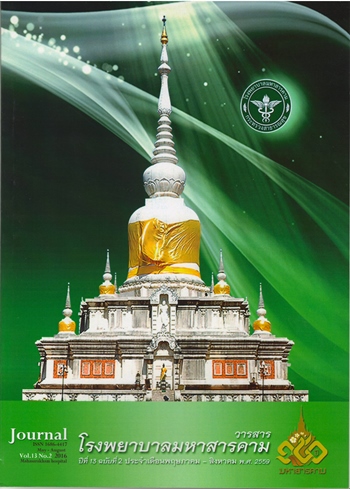Caring, wearing and Complication of Contact Lens among Teenage Students in Uthaithaniprovince: Cross sectional study
Abstract
Objective : To study the behaviors of contact lens cares , wear and complication of contact lens among teenage students in Uthaithani province.
Design : Cross-sectional study.
Methods : A descriptive study was applied to 140 teenage students who wore contact lens all over AmphoeMeuang District, Uthaithani Province. All of the samples were inquired through a set of questionnaires during December 2014 to June 2015. Result : Of the 140 teenage students who wore contact lens, most of them were female (92.14%) and the mean age was 16.82 years. Big-Eye contact lens were in favor among 50% of teenage students. Apparently, 78.57% wore monthly contact lens and 50.71% were dealt with local optical shops. It also found that 42.14% wore contact lens more than 8 hours per day and 32.14% rinsed them (but not rub) before storing. Some of the students (2.14%) simply put contact lens onto their eyes without washing their hands before so doing. Apart from this, 22.86% wore contact lens while sleeping and 10.71% put them on while swimming. 14.29% wore expired contact lens and 7.86% shared them with friends. It found that 107 samples (76.43%) had eye problems -- the most common symptom was burning sensation (45.8%). After feeling unusual symptoms, 15.89% still kept wearing contact lens and waited to see what would happen next. Most of them (63.58%) were not aware of complication that might affect.
Conclusions : Today, the amount of teens wearing contact lens trends to increase despite lacking of understanding the correct usage, cares and complication of contact lens. Education regarding proper usage and cares of contact lens as well as possible hazards related to consuming them will help decrease complication as such.
Keyword : caring, wearing, complication, contact lens, teenage
References
Morgan PB1, Efron N, Toshida H, Nichols JJ. Aninternational analysis of contact lenscompliance.Contact Lens Anterior Eye;34:223-228.
Keay L1, Edwards K, Naduvilath T, Taylor HR,Snibson GR, Forde K, Stapleton F Microbial keratitis predisposing factors and morbidity.Ophthalmology 2006 ;113:109-16.
Wu Y1, Carnt N, Stapleton F. Contact lens user profile, attitudes and level of compliance to lens care.Cont Lens Anterior Eye 2010; ,183-8.
Dart JK1, Radford CF, Minassian D, VermaS, Stapleton F. Risk factors for microbial keratitis with contemporary contact lenses: a case-control study.Ophthalmology
;115,:1647-54.
Tajunisah I1, Ophth M, Reddy SC, Phuah SJ .Knowledge and practice of contact lens wear and care among medical students of University of Malaya.Med J Malaysia.
;63:207-10.
Ky W1, Scherick K, Stenson S . Clinical survey of lens care in contact lens patients.CLAO J. ;24:216-9.
PisitPreechawat , UsaRatananikom ,RungrojLerdvitayasakul, SkowratKunavisarut.Contact lens-related microbial keratitis.J Med Assoc Thai .2007;90:737-43.
Abbouda A1, Restivo L, Bruscolini A, Pirraglia MP,De Marco F. Contact Lens Care among Teenage Students in Italy: A Cross-Sectional Study.SeminOphthalmol. ;21:1-7.
Lee YC1, Lim CW, Saw SM, Koh D. The prevalence and pattern of contact lens use in a Singapore community. CLAO J.2000;26:21-5.
PawineeWongkrajang, Karl J. Neeser1. Knowledge,attitude,practice and eye problems from contact lens in students at Chulalongkorn University 2010. J Health
.2012;26:113-8.
Marjorie J Rah,1 Jeffery Schafer,1 Lening Zhang, OsbertChan. A meta-analysis of studies on cosmetically tinted soft contact lenseslin Ophthalmol.2013; 7: 2037–2042.
Stapleton F, Keay L, Edwards K, Naduvilath T, Dart JKG, Brian G, et al. The incidence of contact lens related microbial keratitis. Ophthalmology. 2008;115:1655–1662.
Dart JKG, Radford CF, Minassian D, Verma S, Stapleton F. Risk factors for microbial keratitis with contemporary contact lenses:acase-control study Ophthalmology. 2008;115:1647–1654.
Fogel J1, ZidileC. Optometry. Contact lenses purchased over the internet place individuals potentially at risk for harmful eye care practices. 2008;79:23-35.
Stapleton F1, Keay L, Edwards K, Naduvilath T, Dart JK. The incidence of contact lensrelated microbial keratitis in Australia. Ophthalmology. 2008;115:1655-62.
Krachmer,Mannis.Complication of contact lens wear .Cornea.2005.vol1;2: 1321-1332.
Athryn A. Dumbleton, , Craig A. Woods, Lyndon W. Jones, Desmond Fonn. The relationship between compliance with lens replacement and contact lens-related problems in silicone hydrogel wearers. Contact Lens and Anterior Eye. 2011;34:-22.
Rosenthal RA1, Henry CL, Schlech BA. Contribution of regimen steps to disinfection of hydrophilic contact lenses. Contact Lens and Anterior Eye.2004 ;27:149-56.
Hiti K1, Walochnik J, Maria Haller-Schober E, Faschinger C, Aspöck H. Efficacy of contact lens storage solutions against different acanthamoeba strains.Cornea. ;25:423-7.
Stapleton F1, Dart JK, Minassian D. Risk factors with contact lens related suppurative keratitis. CLAO J. 1993;19:204-10
P B Morgan1, N Efron1, E A Hill1, M K Raynor2, M A Whiting2, A B Tullo2. Incidence of keratitis of varying severity among contact lens. Br J Ophthalmol 2005;89:430-436
Feys J. Rules and regulations concerning contact lens-related infection. J FrOphtalmol.2004 ;27:420-3.
Thai H. Bui, B.S., H. Dwight Cavanagh, M.D., Ph.D.Patient Compliance During Contact Lens Wear: Perceptions, Awareness, and Behavior. Eye Contact Lens. 2010; 36: 334–339.
Dumbleton K1, Richter D, Woods C,Jones L,Fonn D.Compliance with contact lens replacement in Canada and the United States.Optometry& Vision Science. 2010 ;87:131-9.
Bhandari M1, Hung PR. Habits of contact lens wearers toward lens care in Malaysia.Med J Malaysia. 2012;67:274-7
Downloads
Published
How to Cite
Issue
Section
License
วารสารนี้เป็นลิขสิทธิ์ของโรงพยาบาลมหาสารคาม






